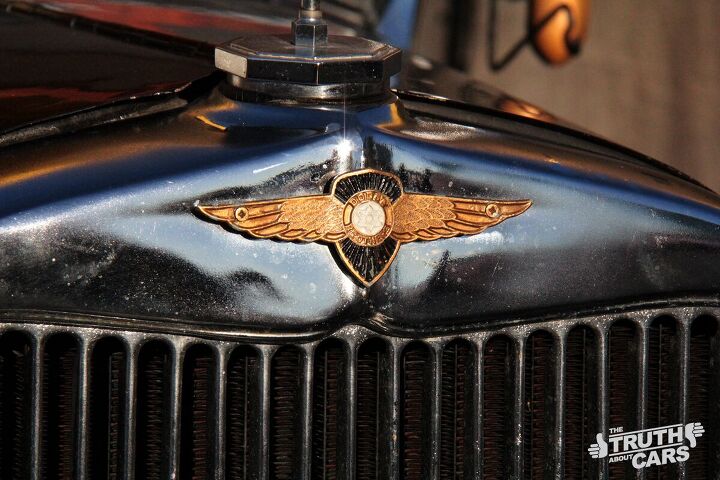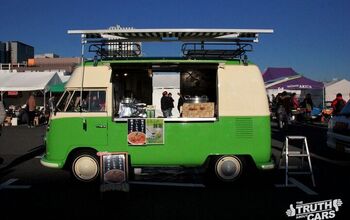Reporting From The Concoures D'eregance In Tokyo: The Americans In Japan

Today, I was in Odaiba, the man-made island in Tokyo Bay. The island is known for its futuristic buildings. Today, it was home of the Japan Classic Car Association’s New Year Meeting. It celebrates the imported car. During the next days, I will show you the nicer ones. We start with the Americans, and a Dodge.
The tonier places in America, like Pebble Beach and Hilton Head, are known for their Concours d’Elegance, something the organizers wanted to bring to Tokyo. It looks like it was damaged in transit.
Some of the first cars in Japan were American, just like this early Dodge Brothers model. The first car made in Japan, in 1902, was powered by a gasoline engine, hand-imported from the U.S. by Komanosuke Uchiyama. Five years later, he produced the first entirely Japanese-made car.
Detroit pretty much owned the Japanese car market before the war. Ford, Chrysler, and General Motors all had production plants in the island nation. Between 1925 and 1936, the Big Three produced 208,967 cars in Japan. Japanese automakers, and there were many, made only 12,127.
Cars imported to Japan, mostly from America and England, did set the style for Japanese cars.
After the war, American makers liked to use their British subsidiaries to export cars to Japan. This is the egg crate grille of a Nash Metropolitan Roadster, built between 1953 and 1961 at Austin’s Longbridge plant.
Except that this Nash has the steering wheel on the left. Must have been the export model.
This is a Ford Prefect, built in the UK.
It looks like the 100E (1953 to 1959). Its steering wheel is at the right left, I mean, it was left at the right side. Next to the Prefect sits a BMW 2002, the predecessor of the 3-series. I had one of those, also in Bavarian Blue.
Wedged between a Porsche and a Triumph, a Shelby GT350. When this car came to Japan, the glory of American imports in Japan began to fade, and the Europeans took over. We will look at them tomorrow.

Bertel Schmitt comes back to journalism after taking a 35 year break in advertising and marketing. He ran and owned advertising agencies in Duesseldorf, Germany, and New York City. Volkswagen A.G. was Bertel's most important corporate account. Schmitt's advertising and marketing career touched many corners of the industry with a special focus on automotive products and services. Since 2004, he lives in Japan and China with his wife <a href="http://www.tomokoandbertel.com"> Tomoko </a>. Bertel Schmitt is a founding board member of the <a href="http://www.offshoresuperseries.com"> Offshore Super Series </a>, an American offshore powerboat racing organization. He is co-owner of the racing team Typhoon.
More by Bertel Schmitt
Latest Car Reviews
Read moreLatest Product Reviews
Read moreRecent Comments
- Arthur Dailey We have a lease coming due in October and no intention of buying the vehicle when the lease is up.Trying to decide on a replacement vehicle our preferences are the Maverick, Subaru Forester and Mazda CX-5 or CX-30.Unfortunately both the Maverick and Subaru are thin on the ground. Would prefer a Maverick with the hybrid, but the wife has 2 'must haves' those being heated seats and blind spot monitoring. That requires a factory order on the Maverick bringing Canadian price in the mid $40k range, and a delivery time of TBD. For the Subaru it looks like we would have to go up 2 trim levels to get those and that also puts it into the mid $40k range.Therefore are contemplating take another 2 or 3 year lease. Hoping that vehicle supply and prices stabilize and purchasing a hybrid or electric when that lease expires. By then we will both be retired, so that vehicle could be a 'forever car'. Any recommendations would be welcomed.
- Eric Wait! They're moving? Mexico??!!
- GrumpyOldMan All modern road vehicles have tachometers in RPM X 1000. I've often wondered if that is a nanny-state regulation to prevent drivers from confusing it with the speedometer. If so, the Ford retro gauges would appear to be illegal.
- Theflyersfan Matthew...read my mind. Those old Probe digital gauges were the best 80s digital gauges out there! (Maybe the first C4 Corvettes would match it...and then the strange Subaru XT ones - OK, the 80s had some interesting digital clusters!) I understand the "why simulate real gauges instead of installing real ones?" argument and it makes sense. On the other hand, with the total onslaught of driver's aid and information now, these screens make sense as all of that info isn't crammed into a small digital cluster between the speedo and tach. If only automakers found a way to get over the fallen over Monolith stuck on the dash design motif. Ultra low effort there guys. And I would have loved to have seen a retro-Mustang, especially Fox body, have an engine that could rev out to 8,000 rpms! You'd likely be picking out metal fragments from pretty much everywhere all weekend long.
- Analoggrotto What the hell kind of news is this?












































Comments
Join the conversation
I've always wondered why JDM cars are RHD. Given the historical precedence of American cars in the early JDM, I would have thought they would drive on the right like we do. Do any of the B&B know why?
And yet, there are a few LHD cars in Japan - some folks like them because they're different - a fair amount of BMWs and Mercs in Japan are LHD. Never mind that they have to use a long pole with a basket to pay highway and bridge tolls.